Papers by Santiago P. Aubourg

The aim of the present study was to comparatively evaluate the effect of different kinds of icing... more The aim of the present study was to comparatively evaluate the effect of different kinds of icing systems employed for the slaughtering and post-mortem storage of cultured turbot (Psetta maxima) on lipid damage (hydrolysis and oxidation). Slurry ice (SI) alone or in presence of ozone (OSI) was applied and compared to the traditional flake ice (FI) treatment. K value and trimethylamine (TMA) formation were also assessed. Some negative effects of ozone presence could be observed on primary and secondary lipid oxidation development; however, oxidation values reached by individuals kept under OSI condition could not be considered high and did not lead to polyunsaturated fatty acid content losses; while ozone presence provided a slowing down of TMA formation. When compared to FI conditions, the employment of SI was found useful to inhibit quality losses (K value and TMA formation), while no differences in lipid hydrolysis or oxidation development could be observed.El objetivo de este est...
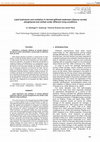
8 pages, 3 figures, 3 tables.[EN] This work focuses on the slaughtering and chilled storage (up t... more 8 pages, 3 figures, 3 tables.[EN] This work focuses on the slaughtering and chilled storage (up to 14 days) related to the commercialization of fresh farmed gilthead seabream (Sparus aurata). A slurry ice (SI) system was applied and evaluated in comparison to traditional flake ice (FI). Lipid hydrolysis and oxidation were analyzed and compared to sensory acceptance and trimethylamine (TMA) formation. An important quality loss could be assessed in fish during slaughtering and chilling storage, according to sensory assessment and TMA formation. However, lipid damage development was found relatively low, in agreement to the different lipid quality indexes checked (lipid hydrolysis; primary, secondary and tertiary lipid oxidation). No development of rancid odor and no polyunsaturated fatty acid losses were detected. The employment of SI as a slaughtering and chilling strategy was found useful to inhibit quality loss in gilthead seabream resulting in a shelf life increase and a TMA and f...

Foods, 2022
This study analyzed the antimicrobial effect of aqueous extracts of flour obtained from red alga ... more This study analyzed the antimicrobial effect of aqueous extracts of flour obtained from red alga (Gelidium sp.) both in vitro, against most common food pathogenic and spoilage bacteria, and in a food model system during the chilled storage of Atlantic mackerel (Scomber scombrus). Results of in vitro assays allowed the conclusion that the aqueous flour extracts have antimicrobial activity against Gram-negative bacteria such as Enterobacteriaceae (Escherichia coli, Enterobacter aerogenes, and Klebsiella pneumoniae) and proteobacteria (Vibrio alginolyticus), and against Gram-positive bacteria such as Bacillus cereus and B. subtilis. In the food model study, different concentrations of the flour extract were present in the icing medium, microbial and chemical analyses being carried out in fish muscle at different storage times. An inhibitory effect (p < 0.05) on microbial growth (aerobes, psychrotrophs, Enterobacteriaceae, and proteolytic and lipolytic bacteria) and on chemical quali...

Molecules, 2021
This work addressed the preservative behaviour of different icing media containing extracts from ... more This work addressed the preservative behaviour of different icing media containing extracts from the alga Bifurcaria bifurcata. A comparative study of the antimicrobial and antioxidant effects of aqueous and ethanolic extracts of this macroalga was carried out. Whole hake (Merluccius merluccius) pieces were stored in ice containing either kind of extract and analysed for quality changes throughout a 13-day storage period. A progressive loss of microbial and biochemical quality was detected in all batches as chilling time increased. A significant inhibitory effect (p < 0.05) on microbial activity could be observed as a result of including the aqueous (lowering of psychrotrophic and lipolytic counts and pH value) and ethanolic (lowering of psychrotrophic and lipolytic counts) extracts. Additionally, both kinds of extract led to a substantial inhibition (p < 0.05) in the lipid hydrolysis rate (formation of free fatty acids), greater in the case of the batch containing ethanolic e...

Antioxidants, 2021
Marine species deteriorate rapidly post-mortem as a consequence of a variety of biochemical and m... more Marine species deteriorate rapidly post-mortem as a consequence of a variety of biochemical and microbial breakdown mechanisms. Due to the increasing demand for high-quality fresh seafood, different strategies are now available to retard spoilage for as long as possible. The present study provides an overview of a recently proposed strategy based on the addition of natural compounds to marine species. In this strategy, different kinds of natural preservative compounds are included in the flake-ice medium that is commonly used for chilled storage. Natural sources tested for this purpose include low-molecular-weight organic acids and different kinds of extracts of plants, macroalgae, and by-products resulting from marine species commercialization. The preservative action of such treatments is analyzed according to the effect on different deteriorative mechanisms (i.e., lipid hydrolysis, oxidation, and microbial activity development), as well as on the resulting sensory acceptability a...
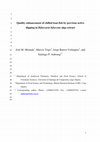
Food and Bioprocess Technology, 2018
The present study addressed the quality enhancement of chilled fish by applying a preliminary dip... more The present study addressed the quality enhancement of chilled fish by applying a preliminary dipping treatment containing a bioactive extract of the alga Bifurcaria bifurcata. Megrim (Lepidorhombus whiffiagonis) specimens were dipped in ethanolicaqueous solutions containing two different concentrations of the alga extract (high: HAC batch and low: LAC batch). Two types of control batch were considered (ethanolwater dipping and no dipping). Microbial, chemical and sensory quality was monitored in fish throughout a 13-day storage period. An inhibitory effect (p < 0.05) of the dipping treatment (washing and the presence of alga extract) on microbial activity was observed, as determined by microbial (Enterobacteriaceae, lipolytic bacteria and psychrotrophs) and chemical (trimethylamine and free fatty acid formation) analysis. In most cases, this effect was found to be more intense for prolonged storage times and in fish specimens corresponding to the HAC batch. However, the combined effect of washing and the inclusion of alga extract in the dipping medium did not affect (p > 0.05) the rate of lipid oxidation events during storage. Interestingly, average scores revealed increased sensory quality in megrim corresponding to the HAC batch for prolonged storage (9-13 days). Consequently, the use of a bioactive extract of B. bifurcata alga as a preliminary dipping treatment can be considered of interest for further fish storage due to both its simplicity and its beneficial effects on fish quality enhancement.
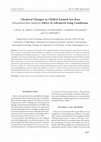
Czech Journal of Food Sciences, 2009
The present research was focused on the commercialisation of fresh farmed sea bass (<I>Dice... more The present research was focused on the commercialisation of fresh farmed sea bass (<I>Dicentrarchus labrax</I>). A slurry ice prototype (60% water/40% ice) coupled to an ozone generator (700 mV, 0.17 mg/l) was tested for the slaughtering and chilling storage (up to 7 days) of this species; comparison with slurry ice treatment alone was undergone. The study was addressed to chemical constituent changes (autolysis, lipid hydrolysis and oxidation, volatile amine formation) in fish muscle related to quality loss; comparison to sensory assessment (skin, eyes, external odour, gills, consistency) was carried out. Increasing values (<I>P</I> < 0.05) with icing time could be observed for autolysis (K value assessment), lipid hydrolysis (free fatty acid formation) and microbiological activity (trimethylamine formation); however, no effect (<I>P</I> > 0.05) of icing time on lipid oxidation (primary and secondary compounds) could be depicted. Concernin...
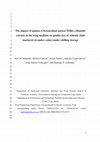
European Journal of Lipid Science and Technology, 2018
The employment of an ethanolic extract of quinoa (Chenopodium quinoa Willd.) as a novel preservat... more The employment of an ethanolic extract of quinoa (Chenopodium quinoa Willd.) as a novel preservation medium and as a source of bioactive compounds is tested for chilled fish storage. For this purpose, specimens from an under‐valued pelagic species (Atlantic chub mackerel, Scomber colias) are stored in ice including quinoa at two concentrations: 80% aq. (v/v) ethanol extracts (0.05 and 0.20 g lyophilized quinoa extract L−1 icing solution; Q‐1 and Q‐2 batches, respectively) and compared to a control icing condition (Q‐0 batch). The evolution of fish quality is assessed during a 13‐day chilled storage period. The presence of the most concentrated quinoa extract (i.e., Q‐2 batch) in the icing medium implied lower (p < 0.05) lipid oxidation (thiobarbituric acid and fluorescence values) and hydrolysis (free fatty acids formation and lipolytic bacteria counts), as well as to a decrease in pH and trimethylamine values. Such effects are more pronounced at advanced storage times. Furthermo...

European Food Research and Technology, 2017
Seaweeds have attracted an increasing attention as a new source for bioactive compounds, these in... more Seaweeds have attracted an increasing attention as a new source for bioactive compounds, these including preservative compounds. This study is a first attempt to employ alga Cystoseira compressa for the preservation of chilled fish. For it, a combined ethanol-aqueous extract of this alga was included in the icing system and employed as chilling medium for the storage of horse mackerel (Trachurus trachurus) during 11 days. On the basis of the microbial groups (aerobes, psychrothrophs, proteolytic, lipolytic and Enterobacteriaceae bacteria) assessed, an inhibitory effect (p<0.05) on microbial activity in horse mackerel muscle was observed as a result of including the alga extract in the icing medium; such preservative effect was also proved by chemical determinations related to microbial activity (pH and trimethylamine values). Additionally, a significant decrease (p<0.05) of lipid hydrolysis (free fatty acids formation) and oxidation (fluorescent compounds formation) in fish was also observed as a result of the presence of C. compressa extracts in the icing medium. The icing medium proposed in this work (i.e., combination of ethanolic and aqueous extracts of C. compressa) may constitute a promising strategy to the application of natural algae extracts for fatty fish storage and enhance the quality retention during commercialisation.
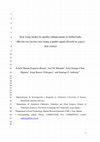
Journal of the science of food and agriculture, Jan 23, 2016
An advanced strategy for chilled fish preservation, based on the inclusion in ice of an extract o... more An advanced strategy for chilled fish preservation, based on the inclusion in ice of an extract of jumbo squid (Dosidicus gigas) skin (JSS), is proposed. Aqueous solutions including acetic acid-ethanol extracts of JSS were tested at two different concentrations as icing media, with the effects on the quality evolution of chilled hake (Merluccius merluccius) being monitored. A significant inhibition (P < 0.05) of microbial activity (aerobes, psychrotrophs, Enterobacteriaceae, proteolytic bacteria; pH, trimethylamine) was obtained in hake corresponding to the icing batch including the highest JSS concentration. Additionally, fish specimens from such icing conditions showed an inhibitory effect (P < 0.05) on lipid hydrolysis development, while no effect (P > 0.05) was depicted for lipid oxidation. Sensory analysis (skin and mucus development; eyes; gills; texture; external odour; raw and cooked flesh odour; flesh taste) indicated a shelf life extension of chilled hake stored i...

International Journal of Food Science & Technology, 2016
SummaryThe study focuses on the impact of icing systems with aqueous (AQ batch), ethanolic (ET ba... more SummaryThe study focuses on the impact of icing systems with aqueous (AQ batch), ethanolic (ET batch) and ethanolic‐aqueous (ET‐AQ batch) extracts of alga Fucus spiralis on the microbial and biochemical quality of chilled hake (Merluccius merluccius). After a 13‐day storage, comparison with fish kept under traditional ice proved a significant (P < 0.05) antimicrobial effect against aerobes, psychrotrophs, proteolytic and lipolytic bacteria, derived of the presence of F. spiralis ethanolic extracts in the icing medium (ET and ET‐AQ batches). Additionally, an inhibitory effect of both ethanol extracts was also obtained concerning lipid oxidation development (i.e. secondary and tertiary lipid oxidation compounds). Additionally, lipid damage assessment showed lower mean values in tertiary oxidation compound formation in hake belonging to the ET‐AQ batch throughout the whole storage period. Present research indicates that ET‐AQ ice condition can lead to a marked quality and safety enh...
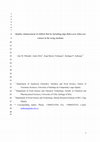
Food and Bioprocess Technology, 2015
Bifurcaria bifurcata is a widely extended brown macroalga, whose antimicrobial and antioxidant pr... more Bifurcaria bifurcata is a widely extended brown macroalga, whose antimicrobial and antioxidant properties have previously been described. In this study, ethanolic extracts of B. bifurcata were included in the icing medium employed for the chilled storage of megrim (Lepidorhombus whiffiagonis). For it, two different concentrations of this brown macroalga extract (0.67 and 2.50 g lyophilized alga L-1 aqueous solution; B-1 and B-2 batches, respectively) were tested for a 14-day storage. The effect of the alga extract was compared with a counterpart batch stored in traditional ice prepared only from water (B-0 batch). Significant (p<0.05) inhibitions of microbial activity (aerobes, psychrotrophs, lipolytic bacteria, proteolytic bacteria and Enterobacteriaceae) as well as of pH and trimethylamine formation, were observed as a result of the incorporation of the alga extract in the icing medium, being this effect especially relevant in the B-2 batch. Concerning lipid damage development, a significantly (p<0.05) lower formation of free fatty acids (lipid hydrolysis development) and of fluorescent compounds (tertiary lipid oxidation development) in samples corresponding to both alga-including batches could also be observed; this inhibitory effect was more intense in fish belonging to the B-2 batch. The icing medium proposed in this work constitutes a promising strategy in order to apply algae extracts to enhance fish quality retention during the different steps of storage and commercialization of marine species.
Grasas y Aceites, 2010
* Average values of three (n = 3) independent determinations. Standard deviations are indicated i... more * Average values of three (n = 3) independent determinations. Standard deviations are indicated in parenthesis. ** For both lipid fractions, no signifi cant differences (p>0.05) as a result icing system and icing time were obtained.
Grasas y Aceites, 2011
A (good), B (fair) and C (unacceptable). Starting fish was category E. For each chilling time, me... more A (good), B (fair) and C (unacceptable). Starting fish was category E. For each chilling time, mean values followed by different superscript letters (a, b) indicate significant (p0.05) differences as a result of the icing condition. ** Abbreviations of icing conditions as expressed in Table 1.
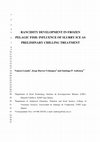
LWT - Food Science and Technology, 2007
The slurry ice technology has shown profitable advantages when employed instead of traditional fl... more The slurry ice technology has shown profitable advantages when employed instead of traditional flake ice for the manufacture of chilled aquatic species. The present work is aimed at evaluating the effect of slurry ice as a preliminary treatment prior to frozen storage. For it, specimens of a small pelagic fatty fish species (sardine; Sardina pilchardus) were stored in slurry ice for 2, 5 and 9 days, then subjected to freezing (-80ºC; 24 h) and finally kept frozen (-20ºC) during 1, 2 and 4 months. At such times, rancidity development in frozen sardine was measured by sensory (odour, skin, colour and flesh appearance) and biochemical (lipid hydrolysis and oxidation) analyses and compared to a control batch previously chilled in flake ice. Sensory analysis indicated an extended shelf-life time for frozen sardine that was preliminary stored under slurry ice for 2, 5 or 9 days, as compared to their counterparts subjected to flake icing. Sensory results were corroborated (p<0.05) by biochemical lipid oxidation indices (thiobarbituric acid reactive substances and the fluorescence formation). The present work opens the way to the use of slurry ice instead of flake ice as preliminary treatment of fish material prior to the frozen storage.
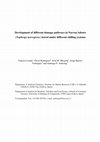
Journal of the Science of Food and Agriculture, 2006
Slurry ice is a biphasic system that has recently shown a number of advantages when employed as a... more Slurry ice is a biphasic system that has recently shown a number of advantages when employed as a chilling medium for fish species. Its use for a crustacean species of high commercial value, Norway lobster (Nephrops norvegicus), was evaluated in parallel with traditional flake icing. Quality parameters related to microbial spoilage and biochemical breakdown (aerobe and psychrotroph counts, pH, K value, total volatile amines, trimethylamine, free fatty acids and non‐enzymatic browning reactions) were assessed and compared with sensory (carapace, eyes, gills, odour and flesh) acceptability. Storage in slurry ice produced a significant (P < 0.05) inhibitory effect on both microbial growth (as determined by aerobes, psychrotrophs and volatile amines) and autolysis breakdown (as determined by K values and the release of free fatty acids) in comparison with the flake ice batch. In contrast, an enhancement effect of slurry ice on carapace browning was observed as a result of enzymatic b...

International Journal of Food Science & Technology, 2011
A novel approach was carried out to inhibit quality loss in chilled blue whiting 3 (Micromesistiu... more A novel approach was carried out to inhibit quality loss in chilled blue whiting 3 (Micromesistius poutassou). For it, a natural organic acid-mixture including ascorbic, 4 citric and lactic acids was applied in a two-step processing. First, as an aqueous dipping medium previous to chilling storage; then, present in ice employed as chilling system. 6 According to indices related to microbiological activity (namely, aerobe and 7 psychrotroph counts) and lipid damage development, results obtained showed a 8 profitable role of the organic acid-mixture; thus, a partial inhibition of both damage 9 pathways was attained, this leading to an increased shelf life time of chilled blue 10 whiting when compared to control fish. Lipid hydrolysis (free fatty acid formation) 11 showed to be a more relevant event than lipid oxidation (peroxide and thiobarbituric 12 acid reactive substance formation) in chilled blue whiting. Microbiological group counts 13 remained as acceptable values for all kinds of samples throughout a 9-day chilling 14 study.

International Journal of Food Science and Technology, 2005
The quality and shelf-life of chilled farmed turbot (Psetta maxima) was evaluated by sensory, mic... more The quality and shelf-life of chilled farmed turbot (Psetta maxima) was evaluated by sensory, microbiological and biochemical procedures after being subjected to a two-step refrigeration storage in slurry ice and flake ice, respectively. Turbot specimens were stored for 10 or 17 days in slurry ice, and then were transferred to flake ice for 1 to 3 days to simulate the sale conditions in the market. The results were compared with control batches stored only in flake ice and processed in parallel. Storage of turbot in the two-step strategy resulted in a better maintenance of sensory quality, especially with regard to its mucus production and gill odour development, better control of microbial activity, especially of aerobes, and the slowing down of some biochemical degradation mechanisms such as the nucleotide degradation pathway and trimethylamine production. As a consequence, the shelf-life was extended significantly. From these results it can be concluded that the refrigerated transport of farmed turbot in slurry ice enhances its shelf-life, before its transfer into flake ice in the retail market.

Uploads
Papers by Santiago P. Aubourg